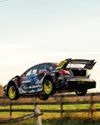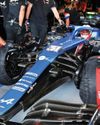
After years in the making, countless hours in the computer design phase – that was further elongated by Covid – and more than 1100 hours in the wind tunnel, NASCAR has finally unveiled its Next Gen regulations that will debut at Daytona, 2022. At a ceremony in North Carolina early in May its three competing manufacturers, Toyota, Ford and Chevrolet, unveiled their contenders for the Cup Series under the moniker of ‘Stock reborn’.
The Next Gen cars are a complete departure from the Gen-6 cars they replace, with new technology in safety, suspension set-up, body panel materials and aerodynamics, as well as a focus on aesthetics and a reduction in cost, in order to make the category more attractive to a potential fourth manufacturer.
There is also thought given to the future powertrain for the category, with the possibility of hybrid technology being introduced into the new platform as a further carrot on the end of the stick to any manufacturer considering joining in the near future.
Some of the more radical and noticeable changes include the manufacturers styling their own cars, meaning a smaller greenhouse and a shorter rear deck, while aero has also changed considerably, particularly under the floor and in the rear diffuser to improve the racing and reduce the risk of a blow-over.
Product relevance
The key point NASCAR was hoping to make with the design of the aerodynamics was that it has put the ‘Stock’ back into Stock Car racing, thereby making the product more relevant to the OEM production line.
Less noticeable, but with more impact in the competition, will be the reduction in downforce, which will make the cars harder to drive on the road courses.
This story is from the July 2021 edition of Racecar Engineering.
Start your 7-day Magzter GOLD free trial to access thousands of curated premium stories, and 8,500+ magazines and newspapers.
Already a subscriber ? Sign In
This story is from the July 2021 edition of Racecar Engineering.
Start your 7-day Magzter GOLD free trial to access thousands of curated premium stories, and 8,500+ magazines and newspapers.
Already a subscriber? Sign In
Talk the torque
More thoughts on in-wheel motors and their effects on twisting force
Rolling about
An explanation of the limitations of a previous load transfer article, bringing jacking forces into the mix
F1 breaks schedule records
The FIA has confirmed no fewer than 23 races on the 2022 Formula 1 World Championship schedule, the highest number of grands prix ever to be held in a single season, and that has led to criticism from some teams that will be on the road for eight months.

Under pressure
Toyota may have finished first and second at Le Mans this year, but the effort required to overcome a fuel delivery problem and finish with both cars was Herculean
Physics at work
Dutch company, Intrax, offers Racecar Engineering an insight into the technologies it employs to optimise its suspension products
Williams' 2030 ambition
Williams Racing has committed to becoming climate positive by 2030 as part of an all-new sustainability strategy.
Diff'rent strokes
Racecar looks at the different types of mechanical differential, their benefits and limitations
Das Boot
A curious Twitter exchange fired up a unique, hydrogen-powered, cross-country project that will contest the Baja 1000 in November 2022

Air born
Every racecar engineer's dream is a blank sheet of paper design. When Hoonigan and Subaru approached Vermont Sportscars about building the next generation of Gymkhana racer, that's just what the company was given

Remote control
Called variously ‘virtual garages’, ‘mission control’ or ‘race support rooms’ is the future of race engineering sitting in the warm back at HQ?